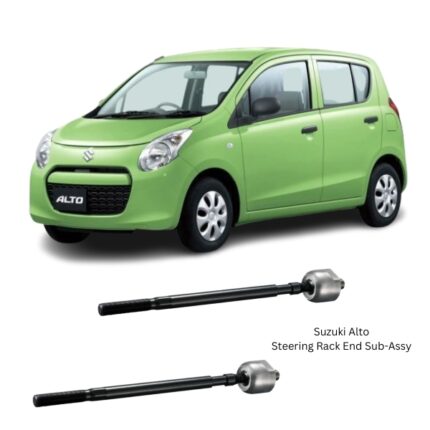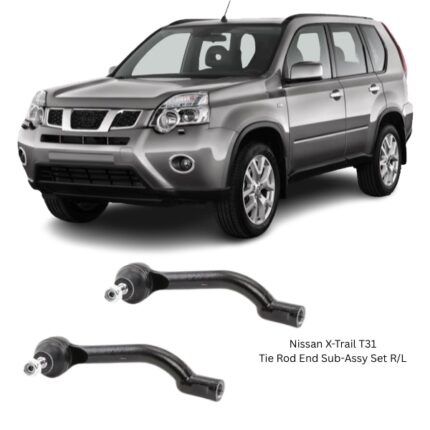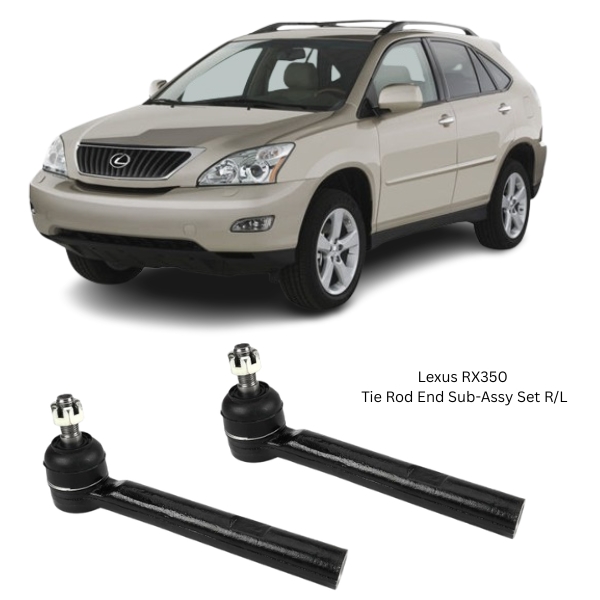Get Lexus RX350 Tie Rod End Sub-Assy Set R/L 45460-29435 in Kenya
The Tie Rod End Sub-Assembly Set (R/L) is a vital part of the automotive steering system. It serves as the critical connecting link between the steering rack end (also known as the inner tie rod) and the steering knuckle. This sub-assembly set includes both the Right-Hand (RH) and Left-Hand (LH) tie rod ends, and they work in tandem to transmit steering input from the driver to the front wheels with precision and consistency.
The integrity of these components directly impacts the vehicle’s handling, steering response, wheel alignment, and tire wear. As such, tie rod ends are precision-engineered to provide reliable performance even under high stress and dynamic driving conditions.
Functionality and Role
The tie rod ends translate the rotational movement of the steering wheel into linear motion, allowing the wheels to turn. The set consists of two key components:
-
Outer Tie Rod End – RH
-
Outer Tie Rod End – LH
Each tie rod end is linked to its respective side of the steering knuckle and threaded onto the inner tie rod. Their primary functions include:
-
Steering Transmission: Transmit movement from the rack-and-pinion or recirculating ball steering system to the wheels.
-
Articulation: Allow for vertical and lateral movement as the suspension travels over road irregularities.
-
Alignment Maintenance: Help set and maintain proper toe angles for optimal tire contact and vehicle stability.
By ensuring these operations, the tie rod end sub-assembly supports responsive, predictable, and safe steering behavior.
Component Breakdown
Each tie rod end sub-assembly includes several essential elements, all designed to withstand wear, load, and environmental conditions:
1. Ball Stud
-
A hardened, spherical pivot that fits into a corresponding socket.
-
Enables rotational and tilting motion for dynamic driving conditions.
-
Designed for high fatigue strength.
2. Ball Socket
-
Encases the ball stud and allows for multi-axis articulation.
-
Typically filled with durable grease and sealed with a boot to prevent contamination.
3. Threaded Shaft
-
Connects the tie rod end to the inner tie rod or adjusts the length for alignment.
-
Features fine threading for precision adjustments.
4. Dust Boot
-
Seals the joint against dirt, water, and road debris.
-
Made from flexible rubber or thermoplastic elastomers.
5. Castle Nut and Cotter Pin
-
Secures the tie rod end to the steering knuckle.
-
Prevents loosening under vibration through mechanical locking.
Right-Hand (RH) vs Left-Hand (LH)
The Tie Rod End Sub-Assembly Set is handed, meaning each piece is specifically designed for the right or left side of the vehicle:
-
RH Tie Rod End: Mounted on the passenger side (in left-hand drive vehicles).
-
LH Tie Rod End: Mounted on the driver side.
Differences between them may include:
-
Thread direction (one may be right-hand threaded and the other left-hand).
-
Length and curvature to match steering geometry.
-
Bend orientation based on clearance and fitment.
Always verify compatibility based on vehicle specifications and steering layout.
Construction and Material Features
Tie rod ends are engineered from high-quality materials to withstand years of mechanical stress:
a) Material Composition
-
High-Carbon Steel: Offers superior tensile and fatigue strength.
-
Heat Treatment: Increases surface hardness and internal durability.
-
Corrosion Protection: Zinc coating, black oxide, or phosphate finishes resist rust.
b) Grease and Sealing
-
Factory-filled grease for long service life.
-
Grease is retained with precision sealing boots, eliminating the need for frequent maintenance in sealed designs.
c) Precision Machining
-
Ensures tight tolerances between the ball and socket.
-
Minimizes play and vibration for improved road feel and control.
Performance Characteristics
The performance of tie rod ends directly affects the vehicle’s drivability. A high-quality tie rod end sub-assembly ensures:
1. Precision Handling
-
Accurate transfer of steering input.
-
Tight responsiveness, especially important at high speeds or in emergency maneuvers.
2. Alignment Retention
-
Helps maintain correct toe settings.
-
Reduces tire scrub and promotes even tire wear.
3. Durability Under Load
-
Withstands vertical loads from road undulations.
-
Absorbs and adapts to frequent directional changes during cornering.
4. Vibration Reduction
-
Reduces steering wheel vibrations caused by road conditions.
-
Damping effect due to ball joint movement and grease lubrication.
Common Signs of Wear
Over time, tie rod ends experience mechanical fatigue and can wear out, leading to degraded vehicle performance. Symptoms of a failing tie rod end include:
-
Loose Steering: Excessive play or wandering steering.
-
Knocking or Clunking Noises: Especially during turns or over bumps.
-
Uneven or Rapid Tire Wear: A result of improper toe alignment.
-
Steering Wheel Vibration: Felt during acceleration or while driving at speed.
-
Poor Handling or Drifting: Vehicle pulls to one side unintentionally.
Inspection and Maintenance
Regular inspection of tie rod ends is vital for steering safety. During service checks:
-
Look for torn boots or grease leaks.
-
Check for free play by manually wiggling the joint.
-
Listen for metallic clunks during steering.
Replacement is recommended in pairs (RH and LH) to ensure consistent wear characteristics and balance.
Installation Notes
When replacing the tie rod end sub-assembly:
-
Mark the original thread position to help retain alignment.
-
Torque to OEM specifications using a calibrated torque wrench.
-
Install new cotter pins or locking hardware.
-
Perform a wheel alignment after installation to restore proper geometry.
Avoid using pneumatic or impact tools to tighten the ball stud nut, as they can damage the joint or overtighten the assembly.
Safety and Compliance Standards
Because tie rod ends are essential safety components, manufacturers are expected to adhere to stringent automotive quality and durability standards, such as:
-
IATF 16949 certification for manufacturing processes.
-
Fatigue Testing: Millions of load cycles to simulate real-world wear.
-
Salt Spray Testing: Assesses corrosion resistance.
-
Ball Pull-Out Strength and torque resistance testing.
Only components that pass rigorous quality control should be used for replacement or repair.
Follow us on Facebook for more parts.





Reviews
Clear filtersThere are no reviews yet.